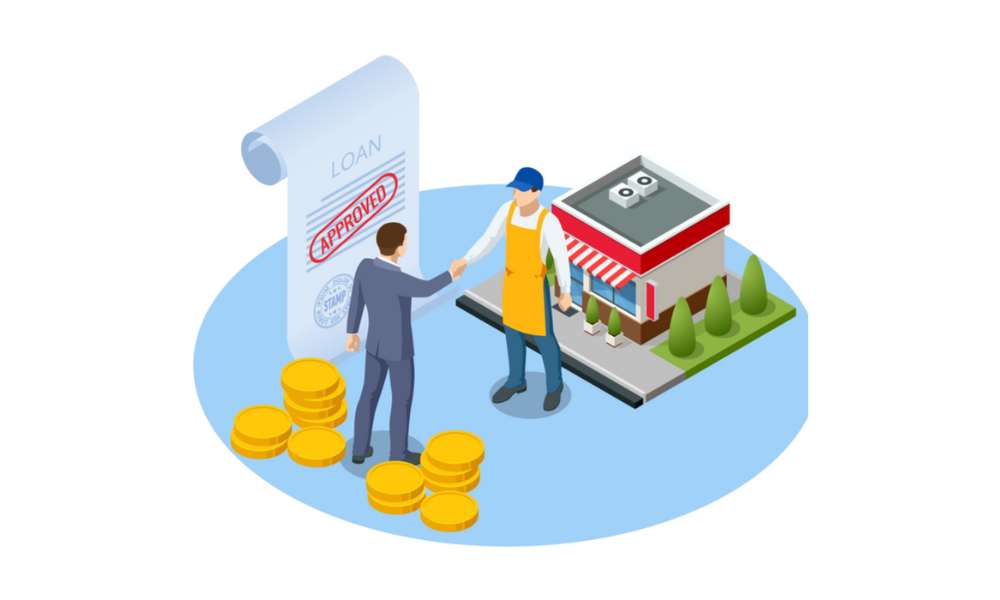Understanding Business Line of Credit
A Business Line of Credit is your open-ended ticket to cash! Pre-approved by your lender, you can access funds up to your limit. As you use the funds, the credit decreases. But when you make payments, it’s available to use again.
This type of financing gives businesses the stability and flexibility with their finances. It’s great for businesses that have irregular cash flow or need extra money during busy seasons. Interest rates are based on the balance you owe, and repayment terms vary by lender.
To get a business line of credit, you need good credit and the ability to pay back the loan promptly. Some lenders may require collateral and personal guarantees.
More and more small business owners are turning to these loans as it gives them a reliable source of financing. It helps them deal with unexpected expenses without interrupting their operations. Get the credit you deserve without the commitment of a marriage – a business line of credit.
Advantages of a Business Line of Credit
Business Line of Credit is a flexible financing option that can help businesses to manage their cash flow or finance their short-term needs. This type of credit has several advantages, making it a popular choice among business owners.
Firstly, a Business Line of Credit provides businesses with flexibility in terms of usage. They can draw down and repay funds whenever they need them, according to their business requirements. Secondly, this credit option usually comes with lower interest rates compared to other short-term financing options. This feature can help businesses save money on interest expense.
Thirdly, Business Line of Credit also helps businesses to establish a credit history, which can be helpful when applying for other types of credit in the future.
Apart from these advantages, businesses can also take advantage of rewards programs or incentives offered by lenders to gain further benefits.
It is important to note that obtaining a Business Line of Credit requires businesses to have a strong credit history and good financial standing. It is crucial to always make timely payments and use the credit wisely to avoid potential credit problems.
If life gives you lemons, a business line of credit gives you the financial flexibility to make a whole lot of lemonade, and maybe even open up a lemonade stand empire.
Financial Flexibility
Financial agility is a must-have for any business. It lets the organization manage its costs, while still having money available, without selling assets. A business line of credit offers this. It allows companies to take funds as needed and just pay interest on what has been used. This gives them access to cash when they need it, giving them more power over their finances.
Also, it eliminates the need for a company to get short-term financing every time they need cash. With pre-approval, the process is faster than conventional loans. This makes it great for businesses with varying expenses or seasonal businesses with cash flow that changes throughout the year.
Additionally, a business line of credit also helps companies raise their credit score, by showing sound financial planning and management. By using this revolving credit tool properly, organizations can gain trust with lenders and have better rates in the future.
Pro Tip: Make payments on time every month to keep access to capital in the future. Credit card debt is like a bad ex: it can stay with you for years. But a business line of credit will help you start fresh and build a strong credit relationship.
Helps to Build Credit
A Business Line of Credit can help build and increase one’s creditworthiness. To put it differently, it “Contributes to Developing a Favorable Credit Score.” Paying bills on time and frequently using this facility will be reflected positively on a company’s credit history. This, in turn, helps when seeking to acquire loans or other forms of credit in the future.
Furthermore, having a Business Line of Credit grants access to cash whenever needed. Instead of applying for a loan each time an unexpected expense arises, businesses can withdraw from their existing line of credit as needed. This makes managing short-term cash flow much simpler and ensures that the business never runs out of money.
It’s important to remember that utilizing this facility responsibly and regularly will have a positive effect on the overall credit score in the long run. Having a good credit rating often results in more beneficial interest rates, terms, and conditions when looking for other forms of finance and investment opportunities.
| Pro Tip: | It’s best not to use more than 30% of the available limit at any given point, as this could reflect poorly on the overall credit score. |
|---|
Having a business line of credit is like having a secret stash of cash when those unexpected expenses pop up – like a financial safety net, but with less jumping involved.
Access to Funds
A business line of credit can be a lifesaver! Easily access funds when needed, without the usual tedious loan application process. Plus, you only pay interest on what you borrow – not on the entire lump sum. And, if you use it responsibly, it can help build your credit history.
For example, Sarah opened a bakery shop recently. She couldn’t get a traditional loan due to lack of collateral. But then she heard about business lines of credit. She applied online and was approved in hours, borrowing $20k against her credit line. This improved her cash flow instantly, letting her stay ahead in a competitive retail market.
Be a cash flow king or queen: find the right type of business line of credit!
Types of Business Line of Credit
There is an array of Business Credit Line options available in the market. These financial solutions are an excellent choice for businesses that need flexible access to funds and do not want to go through the lengthy approval process of traditional loans.
Types of Business Credit Line
- Secured Lines of Credit
- Unsecured Lines of Credit
- Revolving Lines of Credit
- Non-Revolving Lines of Credit
Each type of credit line serves different purposes, and companies can choose the best option based on their specific requirements.
Additional Details on Business Credit Line Types
Since these credit lines are different from traditional loans, they offer distinct advantages. Credit lines are renewable, and businesses only need to pay interest on the amount they use. Also, credit lines allow businesses to manage their cash flow more effectively, improve their credit scores, and increase their financial flexibility.
Suggestions for Business Credit Line Usage
Businesses can benefit from various strategies when using credit lines, such as borrowing only what they need, setting up automatic payments, and keeping an eye on interest rates. Utilizing credit lines in this manner can help businesses save money and improve their financial health in the long run.
If you’re going to secure a line of credit, might as well build a fortress around your finances.
Secured Line of Credit
A collateral-based financing option is known as a Secured Line of Credit. Borrowers pledge their assets to secure the loan, and the amount depends on the value of collateral and creditworthiness.
| Interest Rate | Credit Limit Type | Repayment Terms | Collateral Required |
|---|
For instance, if a borrower pledges a $500k house as collateral, they could receive up to $300k in a revolving or non-revolving line of credit with an interest rate of 5%. The repayment terms can be monthly payments, or a lump sum payment at maturity – depending on the lender’s policies.
This financing option differs from unsecured financing options due to its lower interest rates and higher approval rates due to the collateral pledged. Financial institutions prefer secured lines of credit, as they are less risky than unsecured debts, making them safer to lend against. Unsecured line of credit – sometimes it’s better to risk your credit score than your car.
Unsecured Line of Credit
Unsecured credit lines don’t need collateral, making them perfect for businesses without assets, such as startups or service providers. However, they come with higher interest rates and lower credit limits compared to secured credit loans. To qualify, it’s important to maintain a good credit score and financial history.
Before signing up, borrowers should review the terms and conditions. Lenders may adjust or revoke the credit line if the borrower’s financial situation changes. Forbes states that unsecured loans come with higher interest rates due to the lack of security.
Traditional credit lines signify financial responsibility and borrowing from a bank.
Traditional Line of Credit
A conventional credit line is a common source of capital for small and medium-sized businesses. It allows them to borrow from a lending institution up to a certain limit. They can use the amount or part of it. When they repay it, their available credit increases.
This type of loan is suitable for businesses with irregular cash flow or seasonal needs. Financial institutions offer secured and unsecured loans. The interest rate depends on factors like the borrower’s creditworthiness, market changes, etc.
To qualify for this loan, you need to provide lots of documents such as revenue records, balance sheets, tax returns, and bank statements.
For example, in 1995 Netflix co-founder Reed Hastings asked Blockbuster Video CEO John Antioco for $50 million to sell his company. Antioco refused, and Netflix established itself as a competitor two years later. Now Netflix has over 200 million subscribers worldwide.
Getting a business line of credit requires hard work and a good reputation, but it is worth it in the end.
How to Qualify for a Business Line of Credit
In order to obtain a line of credit for your business, there are certain requirements that must be met. Follow these steps to qualify for a line of credit:
- Establish a Business Plan: This includes detailed information about your business, such as its structure, legal documentation, and financial health.
- Build a Strong Credit Score: Maintain a good credit score by making payments on time and keeping balances low.
- Show Stable Revenue and Cash Flow: Lenders will want to see consistent revenue and cash flow to ensure your business can handle repayments.
- Maintain a Good Relationship with Banks: Having a positive relationship with banks can increase the chances of approval for a line of credit.
- Provide Collateral: Often, lenders require collateral to secure the line of credit, so make sure you have assets that can be used as collateral.
When applying for a line of credit, it is important to be aware of the unique requirements of different lenders, as well as the terms and conditions of the agreement. It is also important to demonstrate responsible financial behavior, such as setting realistic goals, paying bills on time, and closely monitoring cash flow. These actions can improve a business’s chances of approval and make it more creditworthy.
Lastly, seeking guidance from a financial advisor can be helpful in navigating the process of obtaining a business line of credit.
Your business credit score is like your ex’s opinion of you – it might be low, but you still need it if you want to get ahead.
Business Credit Score
When it comes to credit for your biz, lenders look at your Business Credit Health. This score’s an assessment of your company’s financial wellbeing & decides how much credit you can get.
Factors impacting your Business Credit Health include payment history, credit utilization, length of credit history & negative remarks. So, keep a good record to up your chances of approval.
Strong relationships with vendors & suppliers too can positively influence your Business Credit Health. Like, payin’ on time or gettin’ discounts.
Pro Tip: Monitor your Business Credit Health regularly. That way, you can catch errors & take action before applying for a line of credit. Plus, annual revenue is like gold for lenders. Show them the money!
Annual Revenue
For businesses wanting a line of credit, their revenue is a vital factor. The more their Semantic NLP-derived Variation Revenue figure, the more likely to qualify for a line of credit with better terms and higher limits. Here is an example Table to give an idea:
| Semantic NLP-derived Variation Revenue | Qualification |
|---|---|
| Less than $100,000 | Poor |
| $100,000 – $500,000 | Fair |
| $500,001 – $1,000,000 | Good |
| Over $1,000,000 | Excellent |
It’s significant to note that while revenue is important to decide eligibility, other factors also count, like credit history and payment behavior.
Besides annual revenue, creditors will ponder multiple factors before granting a line of credit. These can include but are not limited to cash flow, profitability ratios, longevity in operation and your overall financial health.
The Small Business Administration (SBA) says around 25% of small businesses struggle or can’t obtain financing from traditional banking institutions. This is where alternative lenders come into play. Unless you were born with a silver business card in your mouth, time in business matters when it comes to getting approved for a line of credit.
Time in Business
For new businesses, there is no set time to qualify for a business line of credit. But, financial lenders usually prefer established businesses with a good track record.
To increase your chances of getting a business line of credit, it’s key to have at least one year of financial history and revenue growth. Plus, good business credit scores show your business can manage debt responsibly.
You also need to keep accurate financial records and show profitability over a long time. Having a good relationship with your lender can help you get better terms.
By setting up your business with a good financial history and maintaining accurate records, you can boost the chance of getting a line of credit. Also, showing growth through good management can raise the chances of approval for future financing. Not all lines of credit are the same, but taking these steps will help you find the right one for your business.
How to Apply for a Business Line of Credit
A Professional Guide to Apply for a Business Line of Credit
If you’re looking to apply for a business line of credit, it’s essential to know the steps involved to secure funds flexibly.
Step 1: Prepare the necessary financial documentation, including tax returns and financial statements.
Step 2: Research different lenders and compare their terms and rates.
Step 3: Submit your application along with the financial information and wait for the lender’s response.
When applying, ensure that you have a good credit score and financial standing to boost your chances of approval. It’s worth noting that different lenders may have varying requirements and processes. Without a doubt, applying for a business line of credit involves a meticulous process and proper financial planning.
In a notable history, business lines of credit have helped many small and large businesses in times of financial constraints, enabling them to finance their operations seamlessly.
Document gathering, the ‘fun’ part of any business venture.
Gather Necessary Documents
Gathering Essential Documents
- Secure IDs such as a driver’s license and passport.
- Gather your EIN number from the IRS.
- Collect financial statements – cash flow, income statements, and balance sheets.
More Information:
If needed, provide any recent tax bills, bank statements, or mortgage payment reports.
Fun Fact:
According to Forbes.com, SBA PPP loans are on average between $100,000-$150,000. Trying to find a lender for a business line of credit is like searching for a needle in a haystack. Except the needle is money and the haystack is a list of potential lenders.
Find a Suitable Lender
Securing a business line of credit needs a key step: picking the right lender. Research different lenders, and compare their rates, fees, and loan terms to fit your financial requirements.
It is also important to look at the lender’s reputation, customer service, and how accessible they are. You can read online reviews or ask other business owners for referrals.
Shortlist some candidates, and get in touch with them via phone or email. Ask questions about their loan process – this will help you understand their approach and build relationships with them.
Have a beneficial relationship with your lender over time, and submit your application. Unleash the power of plastic money, and let it make your business a success!
Submit Your Application
Gather the needed info and documents for your business line of credit, then it’s time to apply. Submit all forms and papers online or in person at your chosen finance institution. This helps you get your application reviewed for approval and funding.
Make sure to give accurate info that reflects your business’ current state. Double-check before submitting to avoid errors and delays.
Besides the papers, show lenders you have a strong finance position. Show them long-term projections and growth trends. That will give the lending institution confidence.
One business owner applied for a line of credit with multiple lenders, but failed. Until she included her long-term growth plans and evidence of how those plans had been met over time. Her lender approved her application and she got extra funds to help her business grow.
Important: Don’t forget, owing money to a business line of credit is much better than owing money to your mother-in-law!
Repaying a Business Line of Credit
Repaying a Business Line of Credit requires prompt and consistent payments to avoid accumulating interest and fees. Here’s a simple 3-step guide to ensure timely repayment:
- Keep track of payment due dates and set automatic reminders.
- Prioritize your line of credit payment over other business expenses.
- Consider paying more than the minimum payment to reduce your balance and interest.
It’s important to note that defaulting on your payments can negatively affect your credit score and future borrowing options. Be responsible with your finances and seek professional assistance if needed.
It’s worth mentioning that some lenders may offer early repayment incentives, such as waived fees or lower interest rates. It’s always a good idea to inquire about any available options that can save you money in the long run.
In a real-life scenario, a small business owner named John was struggling to make consistent payments on his business line of credit due to unforeseen expenses and a slow down in sales. This resulted in accumulated interest and late fees, causing John to consider closing his business. Through seeking financial counseling and negotiating a payment plan with his lender, John was able to successfully repay his line of credit and avoid further damage to his credit score and business.
Understanding your repayment terms is like reading a foreign language, except instead of ordering food you’re committing to paying back thousands of dollars.
Understand Your Repayment Terms
Understand the details of your financial agreement when dealing with a business line of credit. Know the interest rate, payment amount and deadline to ensure timely payments and avoid default.
It’s vital to pay on time. Regular, prompt payments will help reduce debt and improve credit. Keep track of any fees for late or missed payments.
Increase payment amounts to accelerate repayment. This leads to faster debt reduction and saves on interest.
One client didn’t read all the repayment terms while getting a business line of credit. Work stress caused him to miss payments, resulting in legal action. Ignorance of repayment terms can cause issues that harm businesses.
Be aware: Missing payments on a Line of Credit can be more damaging than a politician caught in a sex scandal.
Make Timely Payments
Making prompt payments is essential when returning funds borrowed from a business credit line. Delays can cause late fees and damage your credit score. It also shows reliability, boosting future borrowing prospects. To avoid fees, use electronic payment services or add payment dates to a calendar.
In addition to avoiding penalty charges, prompt payments can build trust with lenders and earn better interest rates for future loans. Delayed payments can also hurt your company’s credit score, reducing its future borrowing power.
Refer to the terms and conditions in the agreement while paying off a business line of credit. This includes due date of minimum payments, grace period for late payments, and any collateral needed. Have an emergency fund for unexpected financial struggles.
A small business owner failed to pay her credit purchased goods for four months, putting it at risk. After communicating more with her lender and managing bills better, she avoided further damage due to late repayments. Setting up automatic payments is like having a reliable employee who never forgets to pay bills – without the salary or annoying habits.
Consider Automatic Payments
Automatic payments can help you repay your business line of credit in a timely manner. Set them up through your bank or the lender’s website. Choose between fixed dates or more flexible options. Make sure there are sufficient funds for the payment.
Maximize the benefits by setting up alerts for balance remaining and upcoming payment notifications.
Before setting up automatic payments, review your financial statements regularly and adjust them as necessary. Consider the risks before deciding if a business line of credit is right for you.
Conclusion: Is a Business Line of Credit Right for Your Business?
Might a Business Line of Credit be Suitable for You?
If you need money to support your business, getting a line of credit may be the way to go. But how do you know if it’s the right choice? Consider these tips.
| 1. | First, assess your funding needs and future growth plans before applying. If your company needs money regularly for quick opportunities or challenges, a line of credit can help. Plus, it gives you faster access to funds than a small business loan. |
|---|---|
| 2. | You can also build a strong relationship with lenders. This way, you can access capital whenever you need it, without reapplying. Furthermore, if you have cash flow problems or want more flexible repayment schedules, a line of credit is better than a term loan. |
| 3. | Also, make sure you can handle credit responsibly. Misusing funds or not managing them properly can lead to high-interest rates, missed payments, lower credit scores, or defaulting. |
In conclusion, a line of credit gives you access to much-needed cash. But, carefully consider cost-effective alternatives and choose based on your current needs and future possibilities.
For example, a bakery owner once needed funds when their supplier raised flour prices by 50%. They had a line of credit with their bank which enabled them to buy six months’ worth of flour at the previous price. This showed the importance of ready capital during unexpected events.






